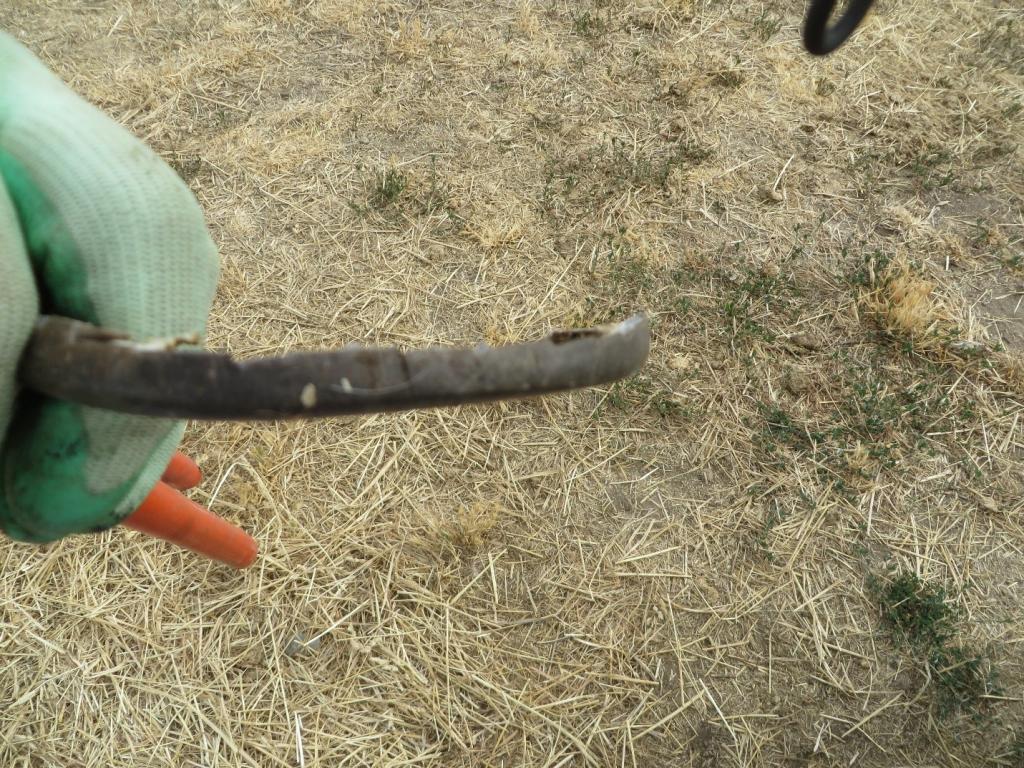Submitted by Karen Bumgarner
There are some basic hoof care principles that I often take for granted that people know. Yet I get surprised and find out that people really don’t know. So here is a little quiz just for fun and savage amusement as you test your basic knowledge.
Q: What is the varnish-like layer of the hoof called?
A: Periople, an often shiny protective covering for the area of newly formed hoof wall just below the coronary band.
 This photo shows the periople outer layer of the hoof wall
This photo shows the periople outer layer of the hoof wall
Q: How much does a healthy hoof grow per month?
A: 1/4 to 1/2 inch, this can be influenced by many things with the most common factors being that of age, exercise, seasons and quality of feed.
 I trimmed off a ¼ inch of hoof and it had been 4 weeks since the last trim.
I trimmed off a ¼ inch of hoof and it had been 4 weeks since the last trim.
Q: Approximately how often should a horse’s foot be trimmed?
A: 4-8 weeks depending upon growth, although I think us endurance riders, especially those who use Gloves and/or Glue On’s tend to trim at least every 4 weeks. I have a few customers who go 8 weeks and sometimes the hoof is really too long. I suggest to most owners to do a light maintenance rasping after 4 weeks if they prefer to have me out every 8 weeks.
Q: Why should you pick out your horse’s hoof regularly?
A: Check for injuries or bruises, check for loose shoes (if you shoe), check for rocks, check for thrush. This task takes less than 5 minutes a day. In fact it takes me longer to find the hoof pick and halter the horse than it does to pick out their hooves. Yet I know riders and horse owners who do not pick out hooves on a regular basis. How do I know? Because their horses are not well behaved when it comes to hoof handling. Yeah – a tattle tale!
 Picking the hoof out should be a part of daily hoof care. This hoof is 4 weeks since the last trim.
Picking the hoof out should be a part of daily hoof care. This hoof is 4 weeks since the last trim.
Q: How do you pick up a front foot safely?
A: Stand beside shoulder, facing rear. Run your hand down the back of the leg to just above fetlock, many people grasp fetlock area and pick up the foot (you can lightly pinch tendon or push shoulder away to help). I find a lot of horses do not like it when you grasp the leg and they want to pull away. You can pinch or turn that horse chestnut slightly and as they pick up their leg just cradle the hoof in your hand. Few horses feel threatened by this manner.
 This is your horse’s “chestnut”, give it a mild squeeze and he will quickly pick up his foot.
This is your horse’s “chestnut”, give it a mild squeeze and he will quickly pick up his foot.
Q: How do you pick up a hind foot safely?
A: Stand to the side facing tail. Stand well out of kicking range. Lean forward and put hand on hindquarters and run down the leg to the fetlock. Ask horse to pick up foot (can pinch tendon/fetlock to help). Some horses are quite compliant and just a tap on the hock and they lift up the hoof. Again I prefer to cradle it in my hand, I find some horses feel threatened if you grasp the fetlock or pastern.
 Hold the hoof lightly with your hand rather than grasping the fetlock or pastern joint. Horses will just let their hoof cradle in your hand.
Hold the hoof lightly with your hand rather than grasping the fetlock or pastern joint. Horses will just let their hoof cradle in your hand.
Q: Name an important point in the care of a horse’s foot.
A: Keep it clean and not standing in manure and filth, prevent it from drying out, trim properly and regularly, trim to keep proper shape/length.
Q: Why might a horse’s hoof need protection?
A: To protect the hoof from excessive wear, protect from concussion and/or bruising, provide traction, help correct defects in stance or gait, help cure disease or defective hoof, ease pain of injured hoof. There are many choices available within EasyCare products to help with all of these.
Q: If the hoof is not trimmed & grows too long, what may happen?
A: Hoof wall cracks, quarter cracks, the hoof chips or breaks off, it may wear or grow unevenly causing stress to the joints and that’s just for starters.
Q: What do you know about a horse’s toe?
A: It is often the greatest point of wear, it usually has the thickest wall and on many horses it is the fastest growing part of the hoof.
Q: Two part question: When holding a horse for the trimmer, on which side should you stand & why?
A: Same side as your trimmer — if horse acts up, you can pull his head toward you & horse’s body will move away from your trimmer.
Q: What is the most elastic part of the hoof?
A: Frog, it should never be over trimmed as this can lead to bruising.
Q: What is the least elastic part of the hoof?
A: Wall, its toughness creates the horse’s base of strength.
I hope that you got them all correct. If not, go out and clean some hooves and marvel at the amazing structure of your horse’s hoof!





